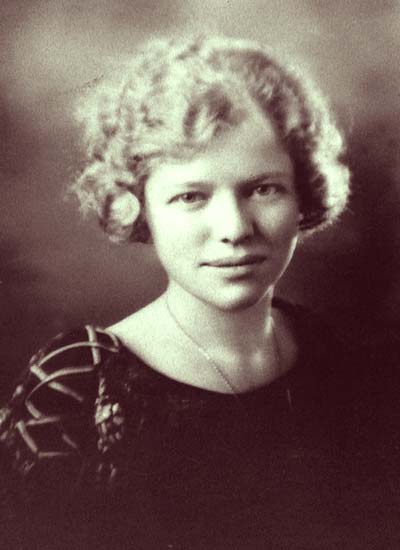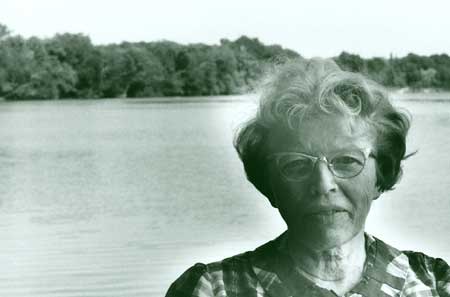
|
Jacket 18 — August 2002 | # 18 Contents | Homepage | Catalog | |
Jenny PenberthyIntroduction to |
Lorine Niedecker: Collected Works. Edited by Jenny PenberthyUniversity of California Press, 472 pages, 6 x 8 inches, 2 b/w photographs Clothbound: $45.00 ISBN-0-520-22433-7 £29.95 |
|
Lorine Niedecker was born in 1903 and died in 1970. Among her published work is New Goose (1946), My Friend Tree (1961), North Central (1968), T&G: Collected Poems, 1936–1966 (1969), My Life by Water: Collected Poems, 1936–1968 (1970), Blue Chicory (1976), From This Condensery (1985), The Granite Pail (1985) and Harpischord & Salt Fish (1991). |
Introduction: Life and Writing‘The Brontes had their moors, I have my marshes,’ Lorine Niedecker wrote of watery, flood-prone Black Hawk Island near the town of Fort Atkinson, Wisconsin, where she lived most of her life.1 Although few people endured for long the seasonal hardships of life on Black Hawk Island, Niedecker’s attachments to the place ran deep. Her life by water could not have been further removed from the avant-garde poetry scene where she also made herself a home. |
|
Even so, the collection of photographs from Lorine’s youth depicts a congenial childhood. There are many images of large family gatherings beside the river at the Inn, everyone dressed in turn-of-the-century finery. Lorine had a close relationship with her grandparents, particularly Gottfried Kunz, ‘a happy, outdoor grandfather who somehow, somewhere had got hold of nursery and folk rhymes to entrance me.’ After the sale of the Fountain House Inn, Henry divided up the Niedecker property into lots, sold some of them, and built and rented cabins on others. He turned the Inn’s pleasure launches into fishing boats and with a partner operated a very successful carp-fishing business. Lorine recalled, ‘I spent my childhood outdoors — red-winged blackbirds, willows, maples, boats, fishing (the smell of tarred nets), twittering and squawking noises from the marsh.’2 Her work is distinguished by its attentive use of sound, a consequence perhaps of her poor eyesight and her experience of her mother’s deafness, but also of her immersion in the rich soundscape of Black Hawk Island. |
| |

|
|
When Lorine was ready to start school, Henry built a large home on Germany Street (renamed Riverside Drive) in Fort Atkinson where the family lived until she entered high school. Her parents then moved back to Black Hawk Island and Lorine billeted with Fort Atkinson friends during the school week. |
| |

|
|
In August 1965, Jonathan Williams offered to publish the manuscript of collected poems that she had prepared and titled T&G. She explained the title as an abbreviation of Lawrence Durrell’s ‘Tenderness and Gristle’ to which Williams added, much to her delight, ‘Tongue and Groove (if you’re a carpenter).’ But Jargon Society financial troubles kept the book in production limbo for four years. Niedecker waited with growing despair until it appeared in 1969. Meanwhile, in 1967, Stuart Montgomery of Fulcrum Press in London solicited poems for another collection. In 1968, North Central was published. It included her two travel- and research-based poems, ‘LAKE SUPERIOR’ and ‘WINTERGREEN RIDGE.’ The same year Stuart Montgomery accepted My Life by Water, which Fulcrum would publish in 1970. Originally planned as the British edition of T&G, it was now expanded to include the contents of North Central plus ‘PAEAN TO PLACE,’ her extended reflection on Black Hawk Island. T&G appeared in 1969, and soon after, Niedecker received Cid Corman’s offer to publish a selected poems. She prepared two typescripts, ‘THE EARTH AND ITS ATMOSPHERE’ and ‘THE VERY VEERY,’ both of which select from the same work represented in North Central, T&G, and My Life by Water. Neither of the typescripts was published. Her final manuscript, ‘HARPSICHORD & SALT FISH,’ ready in 1970 and including the text-derived poems such as ‘THOMAS JEFFERSON,’ ‘HIS CARPETS FLOWERED,’ and ‘DARWIN,’ was also unpublished at the time of her death. Lorine Niedecker . . . will be remembered long and warmly in England, a country she never visited. She was, in the estimation of many, the most interesting woman poet America has yet produced. Her work was austere, free of all ornament, relying on the fundamental rhythms of concise statement, so that to many readers it must have seemed strange and bare. She was only beginning to be appreciated when she died, but I have no doubt at all that in 10 years time Wisconsin will know that she was its most considerable literary figure. |
Notes1. Niedecker and the Correspondence with Zukofsky 1931–1970, ed. Jenny Penberthy (New York: Cambridge University Press, 1993) 146. 2. ‘Extracts from Letters to Kenneth Cox,’ The Full Note: Lorine Niedecker, ed. Peter Dent (Budleigh Salterton, U.K.: Interim, 1983) 36. 3. Lorine Niedecker Collection, Dwight Foster Public Library. 4. Lorine Niedecker: Woman & Poet, ed. Jenny Penberthy (Orono, ME: National Poetry Foundation, 1996) 177. 5. Lorine Niedecker: Woman & Poet 85. 6. Poetry 37.5 (February 1931): 292. 7. Noted by Edward Dahlberg on his copy of New Directions 12 (1950). Eliot Weinberger’s private collection. 8.Lorine Niedecker: Woman & Poet 182. 9.Lorine Niedecker: Woman & Poet 88. 10. Lorine Niedecker: Woman & Poet 188. 11. The Full Note 36. 12. New Mexico Quarterly (Spring 1951): 205. 13. ‘Editor’s Corner,’ New Mexico Quarterly (Summer 1950). 14. ‘Between your House and Mine’: The Letters of Lorine Niedecker to Cid Corman, 1960 to 1970, ed. Lisa Pater Faranda (Durham, N.C.: Duke University Press, 1986) 24. 15. Edward Dahlberg Collection, Harry Ransom Humanities Research Center, University of Texas at Austin.
16. Cid Corman’s transcription from his brief tape-recorded interview with Niedecker. The recording is held at Simon Fraser University in the Contemporary Literature Collection. The quotation appears in Blue Chicory (New Rochelle, NY: Elizabeth, 1976), n.p. |
This Edition
In the last two years of Niedecker’s life, two books of her collected poems were published — T&G: The Collected Poems (1936–1966), prepared in 1965 and published in 1969, and My Life by Water: Collected Poems 1936–1968, an expanded edition prepared in 1968 and published in 1970. Jonathan Williams’s timely offer to publish her collected poems reached Niedecker in 1965, when she was sixty-two years old. Since her first magazine publication in 1928, she had seen two books to press: New Goose in 1946 and My Friend Tree in 1961. Given this spare publication record, the collected poems she now had to compile could not be a conventional alignment of previously published books. Instead she chose to organize an edited selection of poems in a loose chronology of named categories — generic in the case of ‘Ballads,’ ‘In Exchange for Haiku,’ and the folk poems ‘New Goose/My Friend Tree,’ and thematic in the case of ‘For Paul,’ ‘The Years Go By,’ and ‘Home/World’ — a schema that provided the barest allusion to the ambitious provenance of poems written in the course of thirty-five years. The usual autobiographical or biographical cues of an edition of collected poems are muted in T&G to the point where the collection gives the impression of an authorless text. This was perhaps a deliberate choice, consistent with her anti-authorial practice throughout her career — and a locus of her appeal for many readers. However, it was also a choice that may explain her near invisibility on the American scene. |
Notes1. Robert Creeley Papers, Department of Special Collections, Stanford University Libraries. 2. ‘Between Your House and Mine’ 23.
3. Lorine Niedecker: Woman & Poet 89. |
|
Jacket 18 — August 2002
Contents page This material is copyright © Jenny Penberthy
and Jacket magazine 2002 |